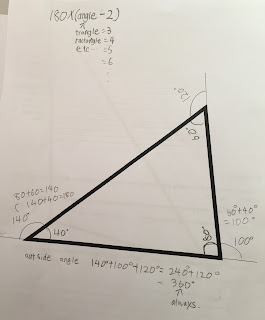How often is that message shared with children?
Mathematicians play with numbers, play with shapes, play with patterns and connections.
To help us discover and experience this key element of what mathematical thinking entails, we reviewed our central idea: When angles co-exist, connections and relationships are formed.
I then shared the idea that maths is play. Had we heard or thought of this before? A few of us had and shared how we can play with numbers to see if strategies work or not. Another shared how a few weeks ago we talked about disproving our theories is a good thing and that she now feels she is constantly playing with different strategies in her mind.
Today we were going to experience how we can play with mathematical thinking.
We tweaked our central idea to
Groups had the following materials on their tables.
The instruction was simple. Play with the triangles to discover some connections or relationships their angles may have.
After about 5 minutes, I started recording on the board what some of us were doing:
Recording what they were doing on the board helped spark interest by other groups to also explore if they exhausted their own ideas. Actually, they didn't need to draw upon what the other groups were doing because they were making fascinating discoveries and building wonderings of their own.
The level of excitement, self-pride and wonder was so high in our room.
Everyone was buzzing from the energy we had created as children shared new discoveries of connections and relationships they were finding with the angles.
Theories were being tested (and without me needing to suggest they test them on other triangles - Phew! We have finally got to that understanding that we need to test and test again theories we create).
Other children excitedly sharing how they just disproved a theory they had formulated. (Another Phew! We have got to the point now where we do know how its great to disprove our own theories)
Not all theories or discoveries were related directly to angle relationships. Some were enquiring into how shapes formed from triangles and others investigated area informally with triangles.
I didn't mind. The excitement of playing with mathematical concepts was key.
On the board, I started adding some wonderings they were trying to discover (there were so many that I didn't record much- Children were eagerly wanting to share with me what they they thinking about)
So many incredible ideas were being created and tested, it is impossible to blog them all:
In the end, we stood in a circle and shared what this experience helped us to understand about maths. So many positive comments were shared and quite a few of us chose to use the 'I used to think.....but now I know.......' thinking routine as a strategy
This group formulated a theory that every triangle must have a hexagon inside it and and now seeing if there is a number pattern that exists:
to share their growth.
A lot to chose to comment on their new discover how mathematical thinking requires play.
What made this such a buzzy learning experience I reflected for a while after:
- student-owned
- completely differentiated
- no pressure in having a predetermined end goal - just play and explore to see what you might discover
- being able to share ideas freely as they arise
- that we now understand that we should create and the prove or disprove our theories
- that enough materials were provided to allow them to explore differently and in a way they may prefer
I'm still buzzing from the buzz we generated today. I feel this was real maths and I now the children are buzzing from it too. :)

















No comments:
Post a Comment
What do you think? ...........